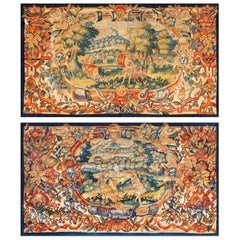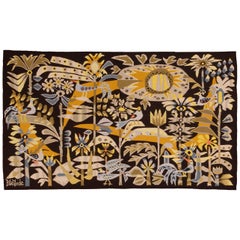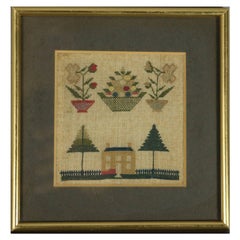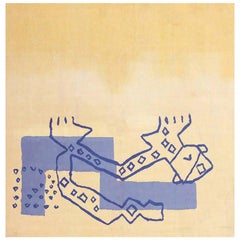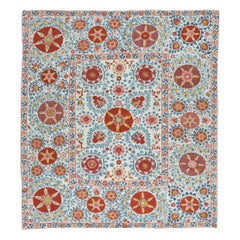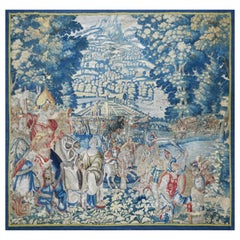Fabric Tapestries
to
1,013
2,130
1,946
3,137
971
138
Height
to
Width
to
519
291
100
88
84
58
58
30
29
21
16
16
14
12
11
8
4
3
747
719
1,671
1,109
290
869
395
46
5
47
37
38
99
135
160
51
20
4,246
2,852
989
922
214
2,058
1,361
1,221
530
417
4,246
3,584
3,815
128
96
59
30
24
Material: Fabric
17th Century Pair of Flemish Tapestry ( 2' x 3'4" - 62 x 102 )
Located in New York, NY
17th Century Pair of Flemish Tapestry ( 2' x 3'4" - 62 x 102 )
Category
Mid-17th Century Belgian Baroque Antique Fabric Tapestries
Materials
Wool, Silk
$9,750 Sale Price / set
25% Off
French Art Deco Tapestry
Located in New York, NY
French Art Deco tapestry
France, circa 1970s
Handwoven
Signed: Bleynie.
Category
Late 20th Century French Art Deco Fabric Tapestries
Materials
Wool
$35,000
Antique Miniature Sampler with House
Located in Chelmsford, Essex
Georgian Miniature Sampler with a House. The sampler is worked in wool and silk threads on a linen ground, mainly in cross stitch. Colours green, yellow, light brown, silver, blue an...
Category
Early 19th Century Antique Fabric Tapestries
Materials
Silk
Vintage Art Deco French Tapestry. Size: 5 ft 9 in x 6 ft
Located in New York, NY
Beautiful textile art square size vintage Art Deco French tapestry, country of origin / Type: French, circa date 1930's. Size: 5 ft 9 in x 6 f...
Category
Early 20th Century French Art Deco Fabric Tapestries
Materials
Wool
4.4x4.8 Ft Embroidered Silk Wall Hanging. Modern Table Cover. New Bedspread
Located in Spring Valley, NY
Introducing our exquisite new suzani hand embroidered wall hanging, a captivating piece that combines ancient craftsmanship with modern artistry. This embroidered cloth is not just a...
Category
2010s Central Asian Suzani Fabric Tapestries
Materials
Cotton, Silk
Circa 1590 Flemish Brussels Tapestry Castle King Holy war Hours sword wool silk
By Flemish
Located in Paris, FR
Dans le respect des traditions, cette magnifique tapisserie a été soumise à un nettoyage en profondeur, à la pose d'une doublure en lin cousue à la main, et à une vérification minuti...
Category
16th Century French Aubusson Antique Fabric Tapestries
Materials
Wool, Silk
Late 19th Century French Figurative Tapestry
Located in New York, NY
Late 19th century French Tapestry
Measures: 7'10" x 8'6".
Category
Late 19th Century French Vienna Secession Antique Fabric Tapestries
Materials
Wool
Lilly STEINER by Atelier Simone ANDRE, French Aubusson moderne tapestry - N 1556
Located in Paris, FR
Atelier Simone ANDRE, Aubusson Tapestry based on a cartoon by Lilly STEINER - L227xH110 cm - No. 1556
Artist: After a Cartoon by Lilly Steiner
Era: 20th Century
Style: Modern Art
Co...
Category
20th Century French Modern Fabric Tapestries
Materials
Wool, Silk
Fine Quality Embroidery on Silk - Qing Dynasty, China, Mid 19th Century
Located in Chatham, ON
Antique fine quality - Qing Dynasty - forbidden or seed stitch silk embroidery panel - metallic and silk threads - densely packed embroidery on a light weight damask pattern silk - m...
Category
Mid-19th Century Chinese Chinese Export Antique Fabric Tapestries
Materials
Silk
$2,100 Sale Price
30% Off
4x5.4 Ft Embroidered Silk Cotton Wall Hanging. Pink Bed Cover. Modern Tablecloth
Located in Spring Valley, NY
Introducing our exquisite new suzani hand embroidered wall hanging, a captivating piece that combines ancient craftsmanship with modern artistry. This embroidered cloth is not just a...
Category
2010s Uzbek Suzani Fabric Tapestries
Materials
Cotton, Silk
$571 Sale Price
20% Off
Mid-Century Modern Danish Wall Tapestry by Hans J. Schöbel for Sodahl
By Södahl AS, Hans J. Schöbel
Located in Waddinxveen, ZH
Stunning wall tapestry of a peacock in orange/brown.
Produced in the 1960's and 70's by Södahl Design A/S, the Danish textiles company founded in 1963 by artist and designer Hans-Jü...
Category
1960s Danish Mid-Century Modern Vintage Fabric Tapestries
Materials
Jute
Pretty Vintage Aubusson Style Jacquard Tapestry
Located in Saint Ouen, FR
"Exquisite late 20th-century French tapestry featuring the enchanting design 'VERDURE AU MOULIN' after François Boucher. Capturing nature in its most picturesque form, adorned with p...
Category
Mid-20th Century French Aubusson Fabric Tapestries
Materials
Wool, Cotton
Large Medieval Style Tree of Life Floral Aubusson Tapestry Wall Hanging
Located in Nottingham, GB
Large Medieval Style Tree of Life Floral Aubusson Tapestry Wall Hanging
From a private collection
Free international shipping.
Category
20th Century Fabric Tapestries
Materials
Cotton
19th Century Uzbek Silk Embroidered Suzani Tapestry
Located in New York, NY
19th century Uzbekistani hand spun linen Suzani with silk embroidered floral motif and silk ikat border. Reverse side has original antique Fine hand printed cotton backing.
Category
19th Century Uzbek Suzani Antique Fabric Tapestries
Materials
Linen, Silk
$5,250 Sale Price
30% Off
Wonderful Vintage South American Andean Peruvian Manta Cloth Kilim weaving
Located in Saint Ouen, FR
Beautiful midcentury Kilim tapestry, Vintage Andean Peruvian Manta Cloth South American Vintage Textiles. A Vintage Manta cloth from the High Andes region of Peru Woven in came-lid f...
Category
Mid-20th Century Peruvian Tribal Fabric Tapestries
Materials
Wool, Cotton
$1,195 Sale Price
20% Off
Jaime Hayon & Nani Marquina 'Nani x Hayon' Wall Tapestry
Located in Tilburg, NL
Jaime Hayon & Nani Marquina 'Nani x Hayon' wall tapestry
Hayon x Nani, size 120x130, comes with wall hanging solution made with fabric sleeves sewn to the top back of the rug.
...
Category
21st Century and Contemporary European Mid-Century Modern Fabric Tapestries
Materials
Wool
Handwoven Ikat Natural Indigo & Plant Dyed Block Framed Artwork
By Pamela Print
Located in Chelmsford, GB
This striking contemporary piece of Handwoven textile art is one of a collection of one-off plant-dyed pieces designed and produced by British Weaver Pamela Print
This piece is dyed...
Category
2010s British Fabric Tapestries
Materials
Wool
Extra Large Mid Century Modern Tapestry by Yugoslav Artist Mateja Rodiqi
Located in Beograd, RS
In this listing you will find a spectacular, extra large wall hanging tapestry designed by a renowned Yugoslav artist Mateja Rodiqi. Tapestry ...
Category
1960s Serbian Mid-Century Modern Vintage Fabric Tapestries
Materials
Wool
Scandinavian Fabric Screen Print by Barbara Brenner for Intair Finland
Located in Chicago, IL
Cotton fabric screen print by Barbara Brenner attached to a wooden stretcher.
Intair - Internationales Stoffdesign.
Category
Mid-20th Century Finnish Mid-Century Modern Fabric Tapestries
Materials
Fabric
Michèle RAY - Modern French Aubusson Tapestry 20th Signed, Monogram, No. 1443
Located in Paris, FR
A stone's throw from the Eiffel Tower We are a family business specializing in the purchase, sale and
expertise of old, modern and contemporary tapestries, rugs, kilims and textiles....
Category
Late 20th Century French Aubusson Fabric Tapestries
Materials
Wool
Bobyrug’s pretty vintage Aubusson style french jacquard tapestry
Located in Saint Ouen, FR
Pretty vintage French Aubusson style tapestry with a nice design and light colours, woven in mechanical jacquard looms with cotton, wool and acrylic,
✨✨✨
"Experience the epitome of...
Category
Mid-20th Century French Aubusson Fabric Tapestries
Materials
Wool, Cotton, Acrylic
$379 Sale Price
20% Off
Vintage Tapestry Depicting a Hidden Forest 5'5" X3'6"
Located in Los Angeles, US
A wall hanging tapestry, simply put, is a textile specifically designed and woven to portray an artistic scene with the intent of hanging it on a wall. Antique tapestries, those that...
Category
Early 2000s Unknown Other Fabric Tapestries
Materials
Wool, Cotton
Antique French Tapestry Handwoven French Tapestry Verdure Scenic Tapestry
Located in New York, NY
Rare Antique French Tapestry Pictorial Woodsman Verdure 1920 Tapestry Large Tapestry Wall Hanging 5'2" x 6'8" 5 x 7 153cm x 204cm
circa 1920
"Thi...
Category
1920s French Vintage Fabric Tapestries
Materials
Wool
Late 16th Century Brussels Historical Tapestry, with Famed Roman General Scipio
Located in New York, NY
A Brussels historical tapestry, attributed to Martin Reymbouts, late 16th century. From the Story of Scipio series, the renowned Roman general, victorious after the Punic War, with k...
Category
16th Century Belgian Antique Fabric Tapestries
Materials
Wool
$149,995 Sale Price
25% Off
Early 19th Century English Framed Needlework
Located in Chapel Hill, NC
Early 19th century English framed sampler, unsigned. Simple with a Georgian brick manor house, crowns, etc. below an alphabet & numbers. Frame scuffs.
...
Category
Early 19th Century English Georgian Antique Fabric Tapestries
Materials
Fabric
19th Century French Aubusson Tapestry
Located in New York, NY
A French Aubusson tapestry from the 19th century, depicting several young courtiers spending a leisurely afternoon gaily dancing and carousing within the splendidly maintained verdan...
Category
19th Century French Aubusson Antique Fabric Tapestries
Materials
Wool
$8,995 Sale Price
50% Off
Modern French Tapestry, Atelier Felletin - Signed Couraud, Edition 1/4 - 1454
Located in Paris, FR
French Hand made Modern French Tapestry AUBUSSON, Atelier Felletin - Signed COURAUD Edition 1/4 - No. 1454
Located a stone's throw from the Eiffel Tower in Paris, we are a French fa...
Category
1960s French Aubusson Vintage Fabric Tapestries
Materials
Wool
Pretty Vintage Aubusson Style Jacquard Tapestry
Located in Saint Ouen, FR
Beautiful vintage French Aubusson style tapestry with a nice design of the nature with trees, vegetation inside the wood, and with a river. and with beautiful colours, entirely woven...
Category
Mid-20th Century French Aubusson Fabric Tapestries
Materials
Wool, Cotton
Antique 19th Century Suzani Panel Wall Hanging
Located in Delray Beach, FL
Antique Uzbek wall hanging made of combination of hand embroidery Suzani squares, silk Ikat, antique velvet and other textile all together with decorativ...
Category
Early 1900s Uzbek Antique Fabric Tapestries
Materials
Cotton, Wool, Velvet, Silk
$900 Sale Price
43% Off
Antique 17th Century Flemish Tapestry 7'11" X 7'9"
Located in Los Angeles, US
A wall hanging tapestry, simply put, is a textile specifically designed and woven to portray an artistic scene with the intent of hanging it on a wall. Antique tapestries, those that...
Category
17th Century Unknown Other Antique Fabric Tapestries
Materials
Wool, Cotton
Mid-Century Modern Tapestry by Jean Picart le Doux, 'Hommage a Paul Eluard'
Located in London, GB
This is a stunning tapestry by the well-known tapestry maker Jean Picart le Doux. It is signed on the bottom right hand side. The tapestry is named 'Homage a Paul Eluard...
Category
1950s French Mid-Century Modern Vintage Fabric Tapestries
Materials
Wool
Bit Map Throw Blanket 03, 100% Cotton Woven Contemporary Pixel Art, 60"x80"
By Luft Tanaka
Located in Brooklyn, NY
Bit map throw blanket 03 by Luft Tanaka Studio
A multicolored graphic throw blanket / wall tapestry woven out of 100 % cotton yarn based on digital pixel art created using an early bitmap drawing software from the 1980s and 1990s.
Measures: 60" x 80" / 152cm x 203cm
The Bit Map Series is based on digital “doodles” Luft makes using Kid Pix, a bitmap drawing software created by Craig Hickman in the 80s & 90s. Throughout the 90s, Kid Pix became a computer lab sensation in primary schools around the globe. Luft too, vividly remembers his first experiences with the the software in his kindergarten classroom, and enjoys creating with the software to this day.
Graphic art generated with the vintage software are edited, converted and digitally woven to make a soft and cozy blanket...
Category
21st Century and Contemporary American Modern Fabric Tapestries
Materials
Cotton
Bobyrug’s Pretty antique French Aubusson Tapestry
Located in Saint Ouen, FR
Very pretty mid century french Aubusson tapestry with beautiful design of a flowerpot with nice colours in a black background.
Entirely handwoven with wool and silk on cotton foundat...
Category
Mid-20th Century French Aubusson Fabric Tapestries
Materials
Wool, Silk
$208 Sale Price
20% Off
Rare, Noble Coat of Arms Tapestry, Order of Santiago, Trogner Family, C. 1650
Located in Dallas, TX
This rare coat of arms tapestry, which was hand-woven circa 1650, originated in the lands that would eventually become Belgium. The beautiful and...
Category
Mid-17th Century Belgian Antique Fabric Tapestries
Materials
Textile, Wool, Linen, Silk
A Source, Jean Lurçat - Moderne French Tapestry Tabard workshop - 180lx127h 1496
By Tabard, Jean Lurçat
Located in Paris, FR
This tapestry has already been cleaned in our craft workshop
Artist: Jean Lurçat (1892-1966)
Era: 20th century
Style: Design 50s-60s
Condition: Perfect condition
Material: Wool
Width...
Category
20th Century French Modern Fabric Tapestries
Materials
Wool
Nice vintage French Aubusson Style Jacquard Tapestry cushion face
Located in Saint Ouen, FR
"Pretty small French tapestry from the late-20th century, featuring a beautiful design and nice colours, woven in jacquard loom by wool acrylic a...
Category
Late 20th Century French Aubusson Fabric Tapestries
Materials
Wool, Cotton, Acrylic
$170 Sale Price
20% Off
Bobyrug’s pretty vintage Egyptian tapestry
Located in Saint Ouen, FR
Pretty vintage Egyptian woven tapestry, in style of Wissa Wassef school tapestries with beautiful childish design and nice colours, entirely hand woven with wool on cotton foundation.
Category
Mid-20th Century Egyptian Kilim Fabric Tapestries
Materials
Wool, Cotton
$1,889 Sale Price
20% Off
Moorish Tapestry with a 19th Century Orientalist Arabian Scene
Located in Moreno Valley, CA
Large Aubusson style european made tapestry with an orientalist 19th century scene depicting an Arabian sultan and other figures and Middle Eastern Moorish architecture in the background.
Probably a scene in North Africa, Morocco, Algeria, Tunisia or Egypt with a sultan well dress sitting and an old man and women around him.
Great textile to use as a wall tapestry decoration.
Unframed antique Belgian or French machine made tapestry depicting a Moorish Islamic scene, typical of late 18th century and early 19th century after the Orientalist scenes.
This is an authentic example of French or Belgian made tapestries...
Category
Early 20th Century French Moorish Fabric Tapestries
Materials
Fabric
Mid-Century Modern Style Catamarca Raw Cotton Wall Tapestry
By AIREDELSUR
Located in Buenos Aires, AR
This dramatic wall hanging is an impressive statement piece for almost any room.Custom sizes and others colors available by request.
Each piece is completely made to order and is av...
Category
2010s Argentine Other Fabric Tapestries
Materials
Cotton
Antique 18th Century Flemish Mythological Tapestry, with the Greek Deity Apollo
Located in New York, NY
An antique 18th century Flemish mythological tapestry, size 11'0 H x 12'6 W. This period European tapestry depicts the Greek God Apollo, who is the deity of the arts, poetry, crops, ...
Category
18th Century Belgian Antique Fabric Tapestries
Materials
Wool, Silk
$25,996 Sale Price
20% Off
18th Century French Aubusson Mythological Tapestry, with Telemachus & Calypso
Located in New York, NY
A French Aubusson tapestry which is very likely part of a set from 'The Story of Telemachus' woven at Aubusson between 1776 and 1800 after engraved designs by various painters including Franc¸ois Boucher Antonio Tempesta and Charles Monnet...
Category
18th Century French Antique Fabric Tapestries
Materials
Wool
$44,995 Sale Price
30% Off
Important Anni Albers style Bauhaus or Black Mountain Period Hand Weaving
By Anni Albers, Bauhaus
Located in Sharon, CT
A period hand woven horizontal rectangles in two yellows and off white in a strict 'implied verticals' geometric Bauhaus or Black Mountain Design. Approximately 26 x 25.75 x 3/8".
Category
Early 20th Century German Bauhaus Fabric Tapestries
Materials
Cotton
Bobyrug’s Pretty Éva Németh handwoven woollen tapestry, Hungary c1970s
Located in Saint Ouen, FR
This woven woollen tapestry features a design of stylised birds and flowers. It is woven in a heavyweight wool using mainly nature-inspired shades of sky blue, yellow and ecru highlighting the flowers and birds. It has the designer's initials NE in the lower right corner. c1970s
Éva Németh...
Category
Mid-20th Century Hungarian Scandinavian Modern Fabric Tapestries
Materials
Wool, Cotton
Late 19th Century French Aubusson Tapestry
Located in Chicago, IL
A beautiful late 19th century French Aubusson tapestry depicting a hunt scene with a hunter mounted on horse with two hounds chasing a stag through a forest...
Category
Late 19th Century French Aubusson Antique Fabric Tapestries
Materials
Wool
Art Nouveau Embroidery, early 20th C. France
Located in Istanbul, TR
A rare item to comedy, has some over all ware., some structural damages. No lining.
Category
Early 20th Century French Art Nouveau Fabric Tapestries
Materials
Metallic Thread
Enzo Mari Wall Hanging Quilted Tapestry Arazzo Canova Adone e Venere, Italy
Located in Vienna, AT
Enzo Mari Wall Hanging Quilted Tapestry Arazzo Canova Adone e Venere, 1999, Italy- Dimensions 102" x 59" x 1"
This large wall hanging designed by Mari was produced in 1999 and is no...
Category
1990s Italian Post-Modern Fabric Tapestries
Materials
Cotton
Late 17th Century Italian Heraldic Coat of Arms Tapestry, Lucca, circa 1690
Located in Encinitas, CA
Aristocratic style is presented by this tapestry; a heraldic coat of arms formed by woolen cloth of different colors applied in collage on blue woolen cloth. Lucchese (Lucca) manufac...
Category
Late 17th Century Italian Baroque Antique Fabric Tapestries
Materials
Wool, Linen
$12,100 Sale Price
44% Off
Vintage Tapestry Depicting the Garden of Eden 6'2" X 5'
Located in Los Angeles, US
A wall hanging tapestry, simply put, is a textile specifically designed and woven to portray an artistic scene with the intent of hanging it on a wall. Antique tapestries, those that...
Category
Early 2000s Unknown Other Fabric Tapestries
Materials
Wool, Cotton
19th Century Italian Religious Banner Ave Maria Oliograph with Tassels Rare
Located in Firenze, Toscana
Beautiful oleograph of Mary and Jesus. Flowers on border. On bottom reads "Ave Maria". Embroidery still in great shape with gold thread. Original wonderful big tassels and bar on top...
Category
19th Century Italian Antique Fabric Tapestries
Materials
Canvas
Late 20th Century Surrealist Carpet Inspired by Joan Miró, Femme Et Oiseaux
By Joan Miró
Located in Dallas, TX
77100 A Surrealist tapestry inspired by Joan Miro's 'Femme et Oiseaux' woman and birds, 1966. The painting was the last of a series the artist complet...
Category
Late 20th Century Chinese Expressionist Fabric Tapestries
Materials
Wool
Beautiful 1960's Wall Tapestry - Rural Landscape
Located in Bern, CH
Beautiful 1960's Wall Tapestry with rural landscape design. Nice example of a Mid Century wall decoration / rug. Yellow, ochre, rust, brown & green colourways.
Measurements: Height: ...
Category
Mid-20th Century Swiss Mid-Century Modern Fabric Tapestries
Materials
Wool, Fabric
Antique Mamluk Revival Egyptian Khedival Khayamiya Cotton Appliquè Hanging
Located in Milan, IT
Derived from the Arabic 'khayam' (tent), the Egyptian khedival khayamiya are elaborately hand-stitched appliquè cotton hangings, woven in the golden period between 1867 and 1914. Wha...
Category
Late 19th Century Egyptian Revival Antique Fabric Tapestries
Materials
Cotton, Linen
Antique Georgian Applique Embroidery of a Country Scene
Located in Chelmsford, Essex
Antique Georgian Applique Embroidery depicting a country scene. The embroidery is worked in a variety of threads and materials, on a felt-like ground. Figures faces and hands are wor...
Category
Early 19th Century Antique Fabric Tapestries
Materials
Felt
21x37 in 100% Silk Wall Hanging. Hand Embroidered Tablecloth. Modern Wall Decor
Located in Spring Valley, NY
Celebrate the rich heritage of Asian craftsmanship with this exquisite 100% silk Suzani textile, meticulously hand-embroidered by skilled artisans. A true work of art, this piece emb...
Category
2010s Central Asian Suzani Fabric Tapestries
Materials
Silk
Jane Knight Fiber Art Textile Jute Rope Wall Hanging Sculpture
By Jane Knight
Located in Troy, MI
Fiber art wall hanging sculpture by Michigan artist Jane Knight (1928-2013)
circa 1980s
9 element piece composed of jute rope and red / orange woolen...
Category
1980s American Mid-Century Modern Vintage Fabric Tapestries
Materials
Wool
Antique Flemish Verdure Tapestry 9'6 x 12'2
Located in New York, NY
Antique flemish verdure tapestry, 9'6 x 12'2. This antique Flemish tapestry, probably from Brussels is a pure verdure, no humans, just one bird and no animals disturb the sylvan tran...
Category
18th Century Dutch Antique Fabric Tapestries
Materials
Wool
Rare Vintage Tapestry with Exquisite Scene of Egyptian Architecture and Columns
Located in Atlanta, GA
Rare Vintage Tapestry with Exquisite Scene of Egyptian Architecture and Columns. 16-1005
This exquisite tapestry from the late 20th century is co...
Category
1980s French Aubusson Vintage Fabric Tapestries
Materials
Wool
$3,150 Sale Price
30% Off
Pretty Vintage French Aubusson Style Jacquard Tapestry « pastoral loves »
Located in Saint Ouen, FR
Introducing a magnificent 20th-century tapestry that captures the essence of the gentle joys of life, festivities, music, and above all, love. Set against a rustic backdrop, shepherd...
Category
Mid-20th Century French Aubusson Fabric Tapestries
Materials
Wool, Cotton, Acrylic
Bobyrug’s Beautiful Vintage Aubusson Style French Jaquar Tapestry
Located in Saint Ouen, FR
Pretty vintage Aubusson style tapestry with beautiful gallant design at beach with beautiful colors, woven with wool and cotton with mechanical Jaquar manufacturing.
✨✨✨
"Experience...
Category
Mid-20th Century French Aubusson Fabric Tapestries
Materials
Wool, Cotton
18th Century Italian Silk & Silver Metallic Thread Lampas Brocade Panel
Located in Rochester, NY
An exceptional and fine hand woven 18th century Italian silk and silver metallic thread lampas brocade panel with beautiful aged original color. Red silk backing w/ attached strip of...
Category
Early 18th Century Italian Renaissance Antique Fabric Tapestries
Materials
Metallic Thread
Recently Viewed
View AllMore Ways To Browse
Brass Vase Persian
Briard Tray
Bronze Borzoi
Bronze Dragon Statue
Bronze Geese
Bronze Mercury Statue
Bronze Odalisque
Bulldog Figurine
Campana Mirror
Cantonese Plate
Carlin Furniture
Carlton Ball Pottery
Cartridge Box
Carved Alabaster Birds
Carved Chest 5 Drawer
Carved Jade Panel
Carved Wooden Statues Of Saints
Caste Designs
